Liang Lin
Adversarially-Aware Robust Object Detector
Jul 22, 2022
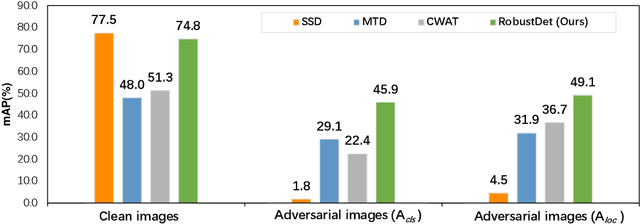


Abstract:Object detection, as a fundamental computer vision task, has achieved a remarkable progress with the emergence of deep neural networks. Nevertheless, few works explore the adversarial robustness of object detectors to resist adversarial attacks for practical applications in various real-world scenarios. Detectors have been greatly challenged by unnoticeable perturbation, with sharp performance drop on clean images and extremely poor performance on adversarial images. In this work, we empirically explore the model training for adversarial robustness in object detection, which greatly attributes to the conflict between learning clean images and adversarial images. To mitigate this issue, we propose a Robust Detector (RobustDet) based on adversarially-aware convolution to disentangle gradients for model learning on clean and adversarial images. RobustDet also employs the Adversarial Image Discriminator (AID) and Consistent Features with Reconstruction (CFR) to ensure a reliable robustness. Extensive experiments on PASCAL VOC and MS-COCO demonstrate that our model effectively disentangles gradients and significantly enhances the detection robustness with maintaining the detection ability on clean images.
* ECCV2022 oral paper
The Lottery Ticket Hypothesis for Self-attention in Convolutional Neural Network
Jul 16, 2022

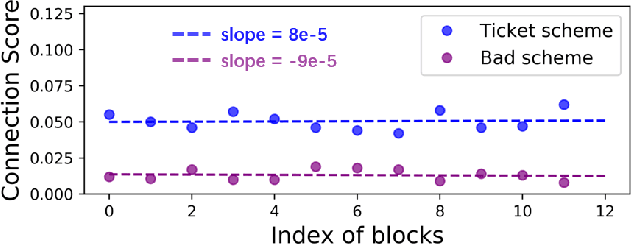
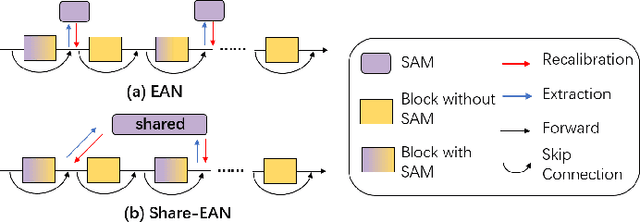
Abstract:Recently many plug-and-play self-attention modules (SAMs) are proposed to enhance the model generalization by exploiting the internal information of deep convolutional neural networks (CNNs). In general, previous works ignore where to plug in the SAMs since they connect the SAMs individually with each block of the entire CNN backbone for granted, leading to incremental computational cost and the number of parameters with the growth of network depth. However, we empirically find and verify some counterintuitive phenomena that: (a) Connecting the SAMs to all the blocks may not always bring the largest performance boost, and connecting to partial blocks would be even better; (b) Adding the SAMs to a CNN may not always bring a performance boost, and instead it may even harm the performance of the original CNN backbone. Therefore, we articulate and demonstrate the Lottery Ticket Hypothesis for Self-attention Networks: a full self-attention network contains a subnetwork with sparse self-attention connections that can (1) accelerate inference, (2) reduce extra parameter increment, and (3) maintain accuracy. In addition to the empirical evidence, this hypothesis is also supported by our theoretical evidence. Furthermore, we propose a simple yet effective reinforcement-learning-based method to search the ticket, i.e., the connection scheme that satisfies the three above-mentioned conditions. Extensive experiments on widely-used benchmark datasets and popular self-attention networks show the effectiveness of our method. Besides, our experiments illustrate that our searched ticket has the capacity of transferring to some vision tasks, e.g., crowd counting and segmentation.
Discourse-Aware Graph Networks for Textual Logical Reasoning
Jul 04, 2022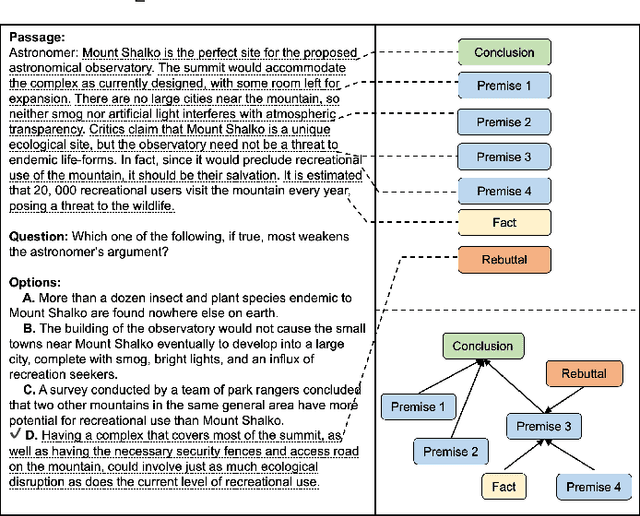
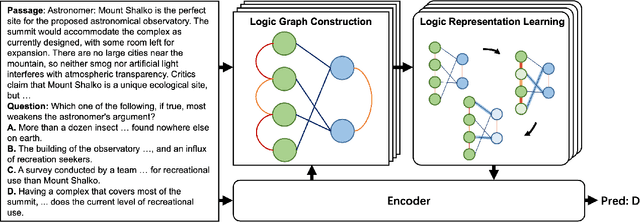
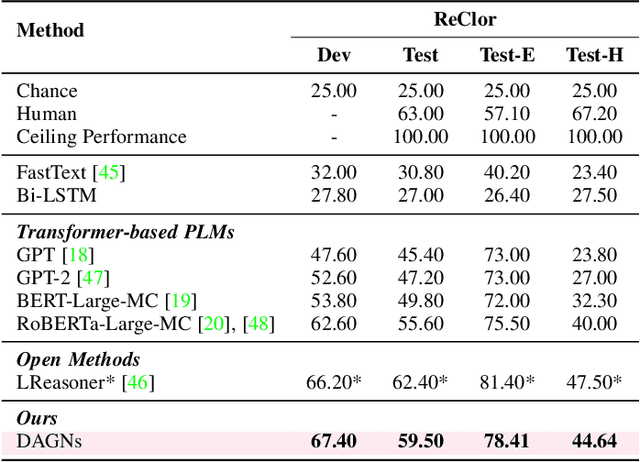
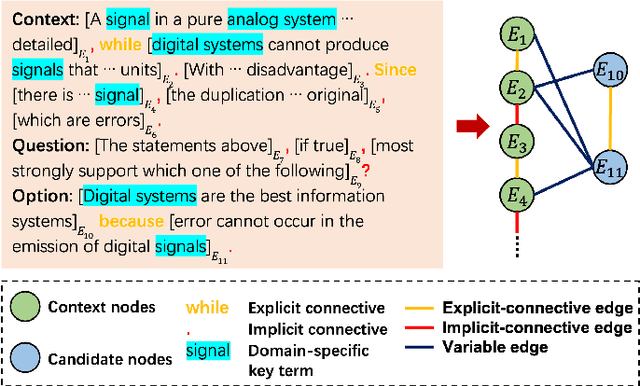
Abstract:Textual logical reasoning, especially question answering (QA) tasks with logical reasoning, requires awareness of particular logical structures. The passage-level logical relations represent entailment or contradiction between propositional units (e.g., a concluding sentence). However, such structures are unexplored as current QA systems focus on entity-based relations. In this work, we propose logic structural-constraint modeling to solve the logical reasoning QA and introduce discourse-aware graph networks (DAGNs). The networks perform two procedures: (1) logic graph construction that leverages in-line discourse connectives as well as generic logic theories, (2) logic representation learning by graph networks that produces structural logic features. This pipeline is applied to a general encoder, whose fundamental features are joined with the high-level logic features for answer prediction. Experiments on three textual logical reasoning datasets demonstrate the reasonability of the logical structures built in DAGNs and the effectiveness of the learned logic features. Moreover, zero-shot transfer results show the features' generality to unseen logical texts.
Real-World Image Super-Resolution by Exclusionary Dual-Learning
Jun 06, 2022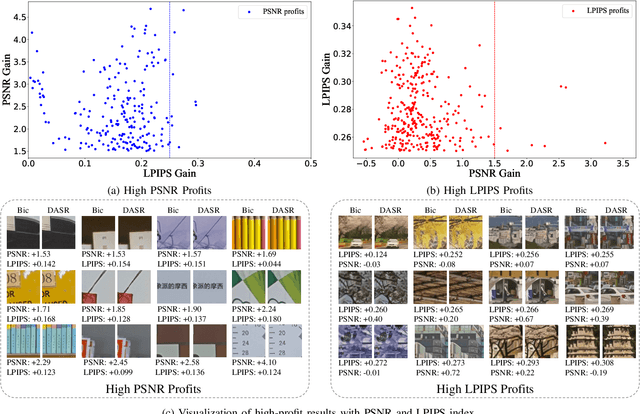
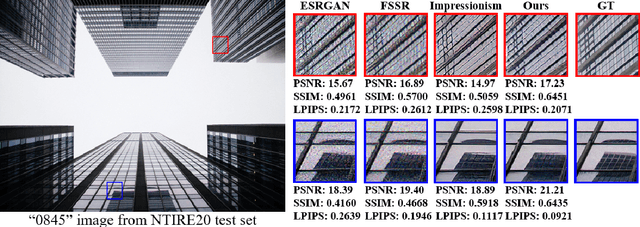


Abstract:Real-world image super-resolution is a practical image restoration problem that aims to obtain high-quality images from in-the-wild input, has recently received considerable attention with regard to its tremendous application potentials. Although deep learning-based methods have achieved promising restoration quality on real-world image super-resolution datasets, they ignore the relationship between L1- and perceptual- minimization and roughly adopt auxiliary large-scale datasets for pre-training. In this paper, we discuss the image types within a corrupted image and the property of perceptual- and Euclidean- based evaluation protocols. Then we propose a method, Real-World image Super-Resolution by Exclusionary Dual-Learning (RWSR-EDL) to address the feature diversity in perceptual- and L1- based cooperative learning. Moreover, a noise-guidance data collection strategy is developed to address the training time consumption in multiple datasets optimization. When an auxiliary dataset is incorporated, RWSR-EDL achieves promising results and repulses any training time increment by adopting the noise-guidance data collection strategy. Extensive experiments show that RWSR-EDL achieves competitive performance over state-of-the-art methods on four in-the-wild image super-resolution datasets.
Semantic-Aware Representation Blending for Multi-Label Image Recognition with Partial Labels
May 26, 2022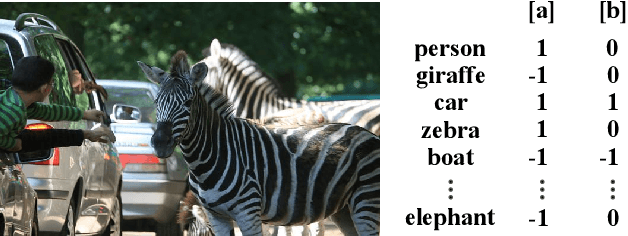
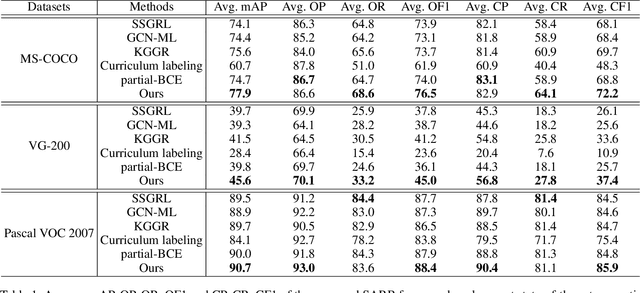
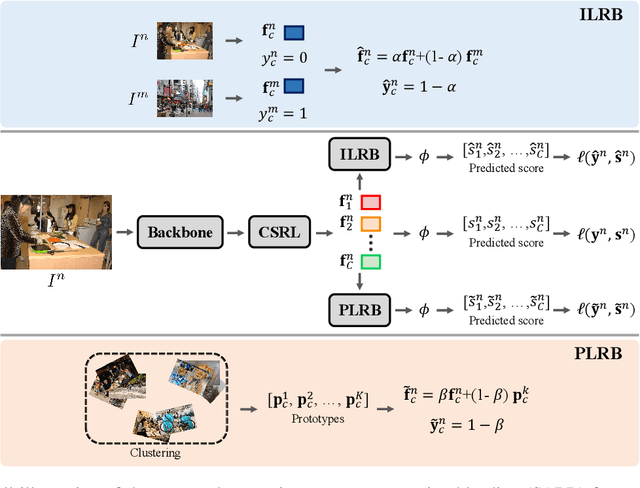
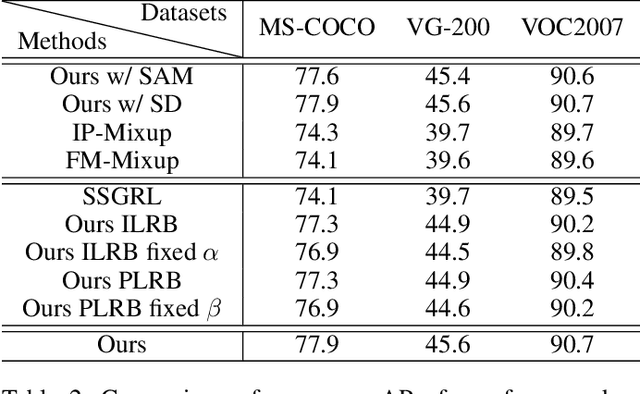
Abstract:Despite achieving impressive progress, current multi-label image recognition (MLR) algorithms heavily depend on large-scale datasets with complete labels, making collecting large-scale datasets extremely time-consuming and labor-intensive. Training the multi-label image recognition models with partial labels (MLR-PL) is an alternative way to address this issue, in which merely some labels are known while others are unknown for each image (see Figure 1). However, current MLP-PL algorithms mainly rely on the pre-trained image classification or similarity models to generate pseudo labels for the unknown labels. Thus, they depend on a certain amount of data annotations and inevitably suffer from obvious performance drops, especially when the known label proportion is low. To address this dilemma, we propose a unified semantic-aware representation blending (SARB) that consists of two crucial modules to blend multi-granularity category-specific semantic representation across different images to transfer information of known labels to complement unknown labels. Extensive experiments on the MS-COCO, Visual Genome, and Pascal VOC 2007 datasets show that the proposed SARB consistently outperforms current state-of-the-art algorithms on all known label proportion settings. Concretely, it obtain the average mAP improvement of 1.9%, 4.5%, 1.0% on the three benchmark datasets compared with the second-best algorithm.
Heterogeneous Semantic Transfer for Multi-label Recognition with Partial Labels
May 23, 2022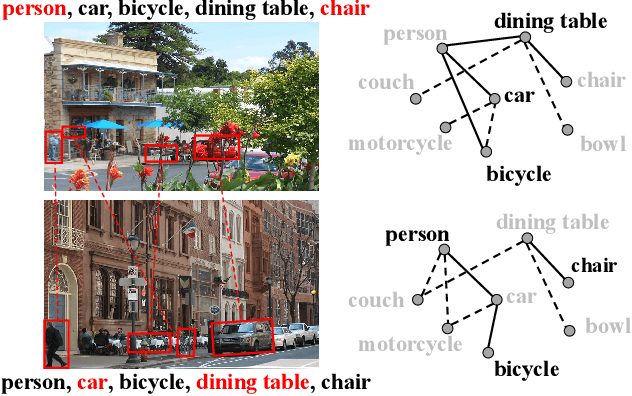
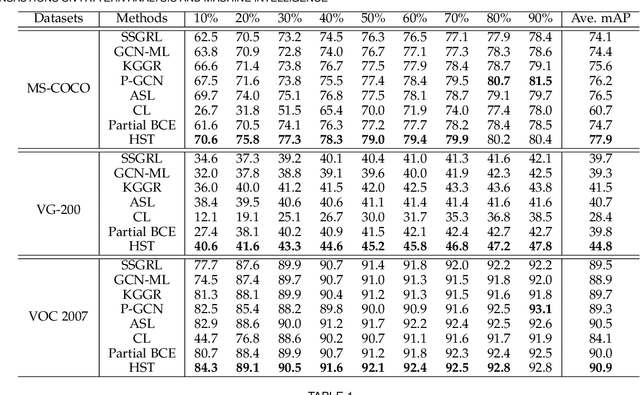

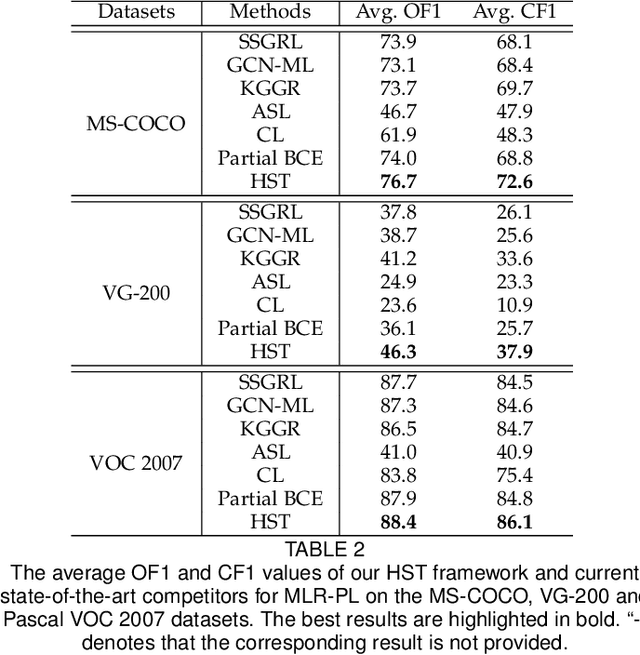
Abstract:Multi-label image recognition with partial labels (MLR-PL), in which some labels are known while others are unknown for each image, may greatly reduce the cost of annotation and thus facilitate large-scale MLR. We find that strong semantic correlations exist within each image and across different images, and these correlations can help transfer the knowledge possessed by the known labels to retrieve the unknown labels and thus improve the performance of the MLR-PL task (see Figure 1). In this work, we propose a novel heterogeneous semantic transfer (HST) framework that consists of two complementary transfer modules that explore both within-image and cross-image semantic correlations to transfer the knowledge possessed by known labels to generate pseudo labels for the unknown labels. Specifically, an intra-image semantic transfer (IST) module learns an image-specific label co-occurrence matrix for each image and maps the known labels to complement the unknown labels based on these matrices. Additionally, a cross-image transfer (CST) module learns category-specific feature-prototype similarities and then helps complement the unknown labels that have high degrees of similarity with the corresponding prototypes. Finally, both the known and generated pseudo labels are used to train MLR models. Extensive experiments conducted on the Microsoft COCO, Visual Genome, and Pascal VOC 2007 datasets show that the proposed HST framework achieves superior performance to that of current state-of-the-art algorithms. Specifically, it obtains mean average precision (mAP) improvements of 1.4%, 3.3%, and 0.4% on the three datasets over the results of the best-performing previously developed algorithm.
LogicSolver: Towards Interpretable Math Word Problem Solving with Logical Prompt-enhanced Learning
May 17, 2022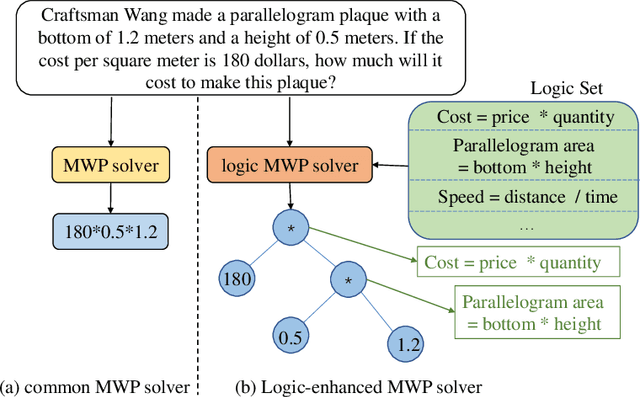


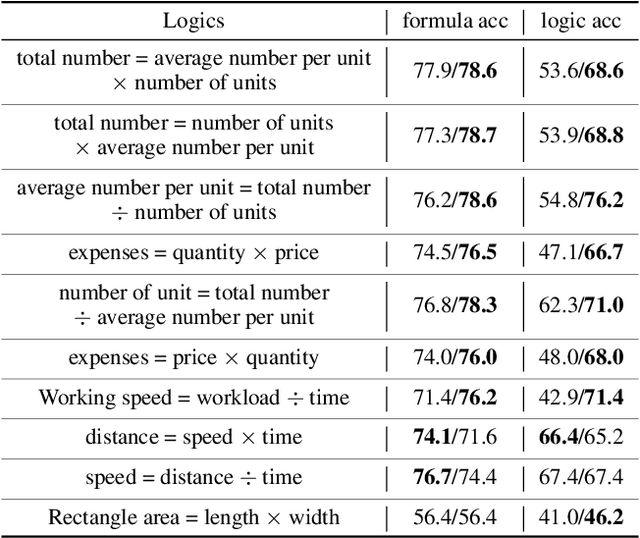
Abstract:Recently, deep learning models have made great progress in MWP solving on answer accuracy. However, they are uninterpretable since they mainly rely on shallow heuristics to achieve high performance without understanding and reasoning the grounded math logic. To address this issue and make a step towards interpretable MWP solving, we first construct a high-quality MWP dataset named InterMWP which consists of 11,495 MWPs and annotates interpretable logical formulas based on algebraic knowledge as the grounded linguistic logic of each solution equation. Different from existing MWP datasets, our InterMWP benchmark asks for a solver to not only output the solution expressions but also predict the corresponding logical formulas. We further propose a novel approach with logical prompt and interpretation generation, called LogicSolver. For each MWP, our LogicSolver first retrieves some highly-correlated algebraic knowledge and then passes them to the backbone model as prompts to improve the semantic representations of MWPs. With these improved semantic representations, our LogicSolver generates corresponding solution expressions and interpretable knowledge formulas in accord with the generated solution expressions, simultaneously. Experimental results show that our LogicSolver has stronger logical formula-based interpretability than baselines while achieving higher answer accuracy with the help of logical prompts, simultaneously.
Dual Adversarial Adaptation for Cross-Device Real-World Image Super-Resolution
May 07, 2022
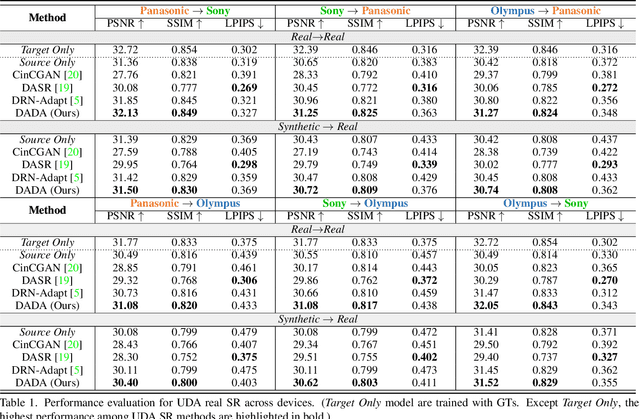
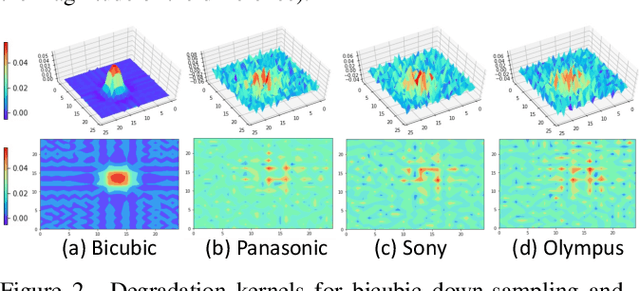

Abstract:Due to the sophisticated imaging process, an identical scene captured by different cameras could exhibit distinct imaging patterns, introducing distinct proficiency among the super-resolution (SR) models trained on images from different devices. In this paper, we investigate a novel and practical task coded cross-device SR, which strives to adapt a real-world SR model trained on the paired images captured by one camera to low-resolution (LR) images captured by arbitrary target devices. The proposed task is highly challenging due to the absence of paired data from various imaging devices. To address this issue, we propose an unsupervised domain adaptation mechanism for real-world SR, named Dual ADversarial Adaptation (DADA), which only requires LR images in the target domain with available real paired data from a source camera. DADA employs the Domain-Invariant Attention (DIA) module to establish the basis of target model training even without HR supervision. Furthermore, the dual framework of DADA facilitates an Inter-domain Adversarial Adaptation (InterAA) in one branch for two LR input images from two domains, and an Intra-domain Adversarial Adaptation (IntraAA) in two branches for an LR input image. InterAA and IntraAA together improve the model transferability from the source domain to the target. We empirically conduct experiments under six Real to Real adaptation settings among three different cameras, and achieve superior performance compared with existing state-of-the-art approaches. We also evaluate the proposed DADA to address the adaptation to the video camera, which presents a promising research topic to promote the wide applications of real-world super-resolution. Our source code is publicly available at https://github.com/lonelyhope/DADA.git.
Continual Object Detection via Prototypical Task Correlation Guided Gating Mechanism
May 06, 2022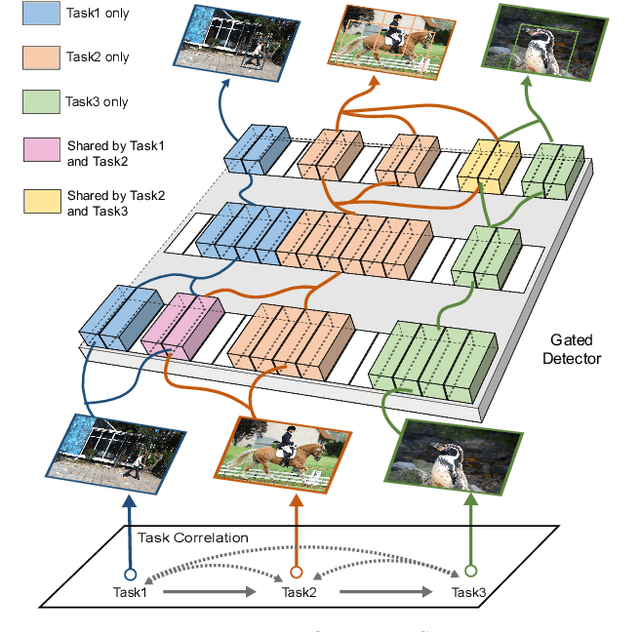
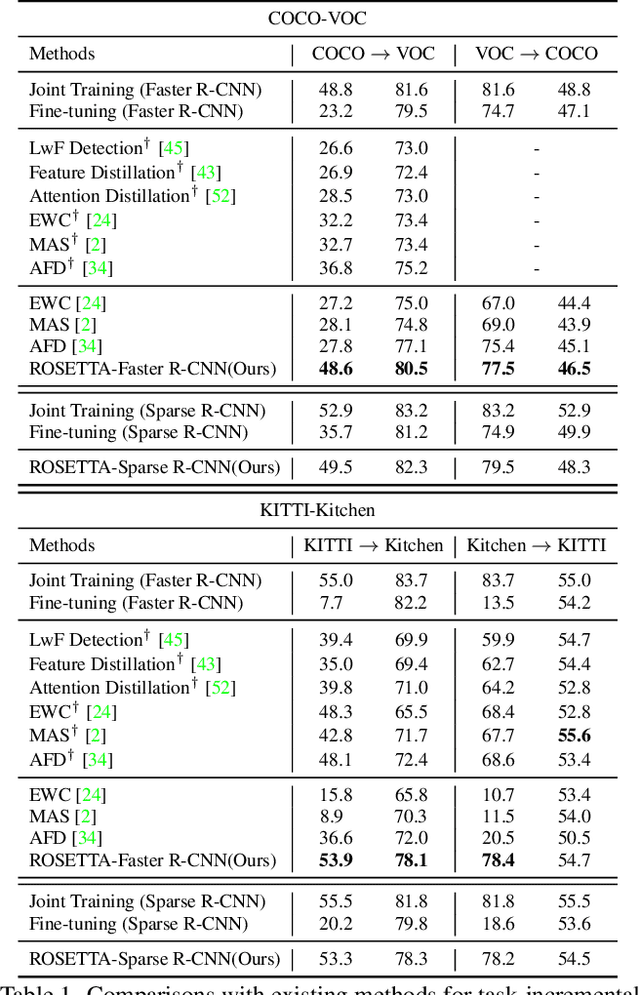
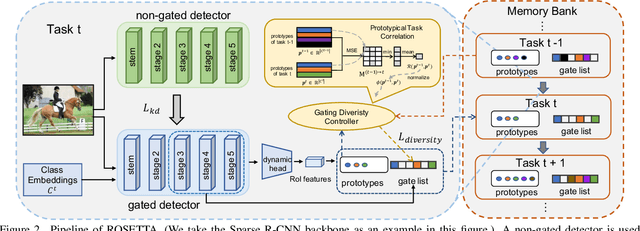
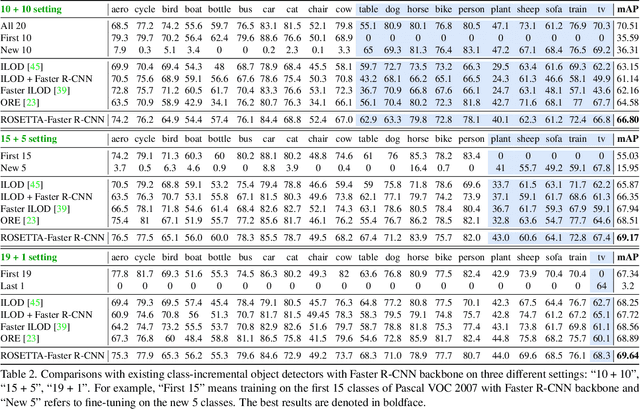
Abstract:Continual learning is a challenging real-world problem for constructing a mature AI system when data are provided in a streaming fashion. Despite recent progress in continual classification, the researches of continual object detection are impeded by the diverse sizes and numbers of objects in each image. Different from previous works that tune the whole network for all tasks, in this work, we present a simple and flexible framework for continual object detection via pRotOtypical taSk corrElaTion guided gaTing mechAnism (ROSETTA). Concretely, a unified framework is shared by all tasks while task-aware gates are introduced to automatically select sub-models for specific tasks. In this way, various knowledge can be successively memorized by storing their corresponding sub-model weights in this system. To make ROSETTA automatically determine which experience is available and useful, a prototypical task correlation guided Gating Diversity Controller(GDC) is introduced to adaptively adjust the diversity of gates for the new task based on class-specific prototypes. GDC module computes class-to-class correlation matrix to depict the cross-task correlation, and hereby activates more exclusive gates for the new task if a significant domain gap is observed. Comprehensive experiments on COCO-VOC, KITTI-Kitchen, class-incremental detection on VOC and sequential learning of four tasks show that ROSETTA yields state-of-the-art performance on both task-based and class-based continual object detection.
Causal Reasoning with Spatial-temporal Representation Learning: A Prospective Study
May 05, 2022
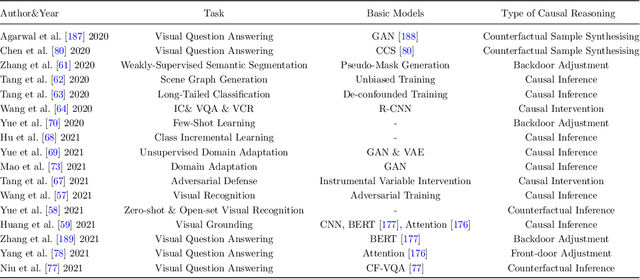

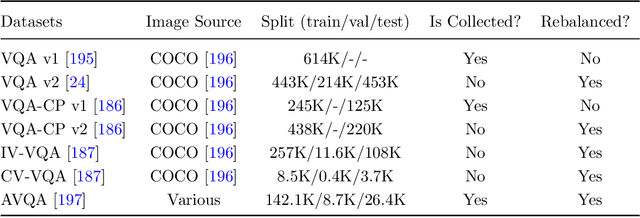
Abstract:Spatial-temporal representation learning is ubiquitous in various real-world applications, including visual comprehension, video understanding, multi-modal analysis, human-computer interaction, and urban computing. Due to the emergence of huge amounts of multi-modal heterogeneous spatial/temporal/spatial-temporal data in big data era, the lack of interpretability, robustness, and out-of-distribution generalization are becoming the challenges of the existing visual models. The majority of the existing methods tend to fit the original data/variable distributions and ignore the essential causal relations behind the multi-modal knowledge, which lacks an unified guidance and analysis about why modern spatial-temporal representation learning methods are easily collapse into data bias and have limited generalization and cognitive abilities. Inspired by the strong inference ability of human-level agents, recent years have therefore witnessed great effort in developing causal reasoning paradigms to realize robust representation and model learning with good cognitive ability. In this paper, we conduct a comprehensive review of existing causal reasoning methods for spatial-temporal representation learning, covering fundamental theories, models, and datasets. The limitations of current methods and datasets are also discussed. Moreover, we propose some primary challenges, opportunities, and future research directions for benchmarking causal reasoning algorithms in spatial-temporal representation learning. This paper aims to provide a comprehensive overview of this emerging field, attract attention, encourage discussions, bring to the forefront the urgency of developing novel causal reasoning methods, publicly available benchmarks, and consensus-building standards for reliable spatial-temporal representation learning and related real-world applications more efficiently.
 Add to Chrome
Add to Chrome Add to Firefox
Add to Firefox Add to Edge
Add to Edge